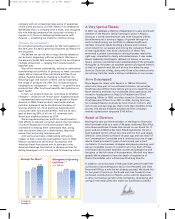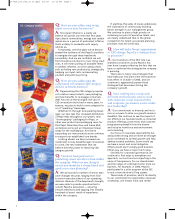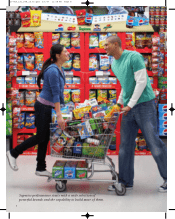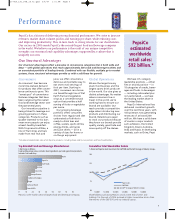Pepsi 2006 Annual Report Download - page 14
Download and view the complete annual report
Please find page 14 of the 2006 Pepsi annual report below. You can navigate through the pages in the report by either clicking on the pages listed below, or by using the keyword search tool below to find specific information within the annual report.
12
Our goal is to make our products available wherever there are hungry
or thirsty people.
PepsiCo offers a variety of products that are delicious and nutritious.
opportunity awaits us in the
world of non-carbonated
beverages, as we currently
account for less than 2% of
an international non-carbon-
ated beverage industry that
we estimate to be about $70
billion and growing.
Strategic Acuity
—
Health and Wellness
Providing consumers with
choices has long been a part
of our mindset. We introduced
Diet Pepsi in 1964 and Reduced
Fat Ruffles in the mid 80s. We
have historically supported
active lifestyles as well.
Throughout the world, PepsiCo
is a frequent sponsor of
sports and active lifestyles
through our marketing and
our charitable donations.
Our increasing commitment
to health and wellness is
reflected in the transformation
of our portfolio, such as
through our acquisitions of
Tropicana and Quaker. That
commitment is behind our
creation of a Blue Ribbon
Health and Wellness Advisory
Board, a group that provides
expert advice on a variety of
initiatives including new
products, nutrition news and
exercise programs. And it has
driven our work to improve
the nutritional profile of our
existing product lines. In
2003, long before concerns
about trans fats became the
subject of mainstream media,
PepsiCo removed trans fats
from Doritos, Cheetos and
Tostitos in the United States
and Canada, by converting to
corn oil — a vegetable oil
high in good fats, mono- and
polyunsaturated fatty acids.
In 2006, we changed the oils
in our Lay’s and Ruffles brand
potato chips in the United
States and internationally in
Walkers crisps, moving to
sunflower oil, which is lower
in saturated fat.
We are pioneers in offering
consumers smart choices. In
2004, we introduced the
Smart Spot symbol in the
United States, a first-of-its-
kind designation that helps
consumers identify PepsiCo
products that can contribute
to healthier lifestyles. Products
with the Smart Spot symbol
meet nutrition criteria based
on authoritative statements
from the U.S. Food and
Drug Administration and the
National Academy of Sciences
or provide other functional
benefits. More than 40% of
our revenues in the United
States and Canada come
from products that are Smart
Spot eligible.
beverages — and we added a
premium brand to help us
capture the growth: Izze
Beverage Co. Acquired in
2006, Izze is a maker of all-
natural sparkling fruit juices.
To extend our lead in non-
carbonated beverages, we
recently completed the
acquisition of Naked Juice, a
premium juice producer in the
United States whose portfolio
includes fruit juices and
smoothies made without
added sugars or preservatives.
Internationally, we have a
variety of non-carbonated
products including Tropicana,
Gatorade and Lipton products,
plus local juices such as
Copella fruit juices and PJ
Smoothies in the United
Kingdom, and Punica, a
leading German maker of
fruit juices and juice drinks,
acquired in 2005. A huge
267419_L01_P08_15.v2.qxd 3/4/07 12:02 AM Page 12
























